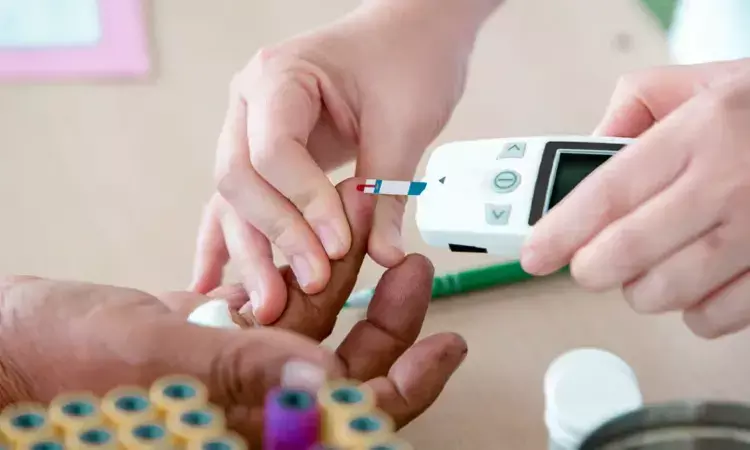- Home
- Medical news & Guidelines
- Anesthesiology
- Cardiology and CTVS
- Critical Care
- Dentistry
- Dermatology
- Diabetes and Endocrinology
- ENT
- Gastroenterology
- Medicine
- Nephrology
- Neurology
- Obstretics-Gynaecology
- Oncology
- Ophthalmology
- Orthopaedics
- Pediatrics-Neonatology
- Psychiatry
- Pulmonology
- Radiology
- Surgery
- Urology
- Laboratory Medicine
- Diet
- Nursing
- Paramedical
- Physiotherapy
- Health news
- Fact Check
- Bone Health Fact Check
- Brain Health Fact Check
- Cancer Related Fact Check
- Child Care Fact Check
- Dental and oral health fact check
- Diabetes and metabolic health fact check
- Diet and Nutrition Fact Check
- Eye and ENT Care Fact Check
- Fitness fact check
- Gut health fact check
- Heart health fact check
- Kidney health fact check
- Medical education fact check
- Men's health fact check
- Respiratory fact check
- Skin and hair care fact check
- Vaccine and Immunization fact check
- Women's health fact check
- AYUSH
- State News
- Andaman and Nicobar Islands
- Andhra Pradesh
- Arunachal Pradesh
- Assam
- Bihar
- Chandigarh
- Chattisgarh
- Dadra and Nagar Haveli
- Daman and Diu
- Delhi
- Goa
- Gujarat
- Haryana
- Himachal Pradesh
- Jammu & Kashmir
- Jharkhand
- Karnataka
- Kerala
- Ladakh
- Lakshadweep
- Madhya Pradesh
- Maharashtra
- Manipur
- Meghalaya
- Mizoram
- Nagaland
- Odisha
- Puducherry
- Punjab
- Rajasthan
- Sikkim
- Tamil Nadu
- Telangana
- Tripura
- Uttar Pradesh
- Uttrakhand
- West Bengal
- Medical Education
- Industry
Stress Hyperglycemia Ratio Identified as Predictor of Early Mortality in Acute CV Disease: Study

A new study published in the journal of BMC Cardiovascular Diabetology revealed that an elevated stress hyperglycemia ratio (SHR) is linked to increased early mortality in cardiovascular disease patients, even after adjusting for confounders. While SHR enhances short-term risk prediction, its long-term prognostic value diminishes.
Although the stress hyperglycemia ratio has gained attention as a possible prognostic indicator in critical disease, nothing is known about how it relates to cardiovascular disease mortality. Using propensity score matching (PSM) to account for a number of confounding variables, this study examined the association between SHR and all-cause mortality in critically ill patients with cardiovascular disease.
SHR quartiles were used to stratify a group of 3,352 critically sick cardiovascular disease patients (Q1–Q4). A sizable database of de-identified health information on patients hospitalized to Beth Israel Deaconess Medical Center's intensive care units (ICUs) was searched for baseline features, comorbidities (diabetes and heart failure), and severity ratings (OASIS, APSIII, and SOFA). Covariates between high (SHR > 1.355) and low SHR groups were balanced using PSM (670 matched pairs).
SHR and mortality risk (in-hospital, 28-day, 90-day, and 365-day) were compared using Kaplan-Meier survival curves, Cox models, and restricted cubic spline (RCS) analysis. 3 successive adjustment levels were used to the Cox proportional hazards models: Model 1 (unadjusted), Model 2 (adjusted for comorbidities and demographic variables), and Model 3 (completely adjusted). Area under the curve (AUC) improvement was used to evaluate the predictive ability of SHR in conjunction with severity scores.
Comorbidity load (e.g., acute renal injury: 84.6% in Q4 vs. 79.7% in Q1, P < 0.001) and severity ratings (P < 0.001) were higher in higher SHR quartiles. SHR and mortality were significantly correlated, according to unadjusted analysis, with Q4 having the greatest 365-day mortality (Q4: 29.2% vs. Q1–Q3: 15.7–16.9%, P < 0.001) and in-hospital mortality (Q4: 16.3% vs. Q1–Q3: 5.1–6.4%, P < 0.001).
A U-shaped mortality risk was found by the RCS analysis, with average ideal SHR cutoffs of 1.355. High SHR (Q4) was still linked to early mortality (in-hospital HR = 2.117, [95% CI: 1.223–3.665], P = 0.007; 28-day HR = 1.859, [95% CI: 1.100-3.141], P = 0.020) but not long-term outcomes (90-day mortality, P = 0.127; 365-day mortality, P = 0.123) in Model 1 following PSM, according to cox proportional hazard models.
Similar patterns were seen in the fully adjusted model (Model 3) and after controlling for comorbidities and demographic covariates (Model 2). OASIS and predictive efficacy of SAPSII for 90- and 365-day death prediction following PSM was not improved by adding SHR, though. Overall, the results found SHR as an easily available biomarker for short-term risk stratification in cardiovascular disease, especially in acute situations when early intervention may enhance outcomes.
Source:
Lei, M., Li, Y., Cheng, L., Tang, N., Song, J., Song, M., Su, Q., Liu, M., Fu, S., Lin, F., & Gao, Y. (2025). Stress hyperglycemia ratio as a biomarker for early mortality risk stratification in cardiovascular disease: a propensity-matched analysis. Cardiovascular Diabetology, 24(1), 286. https://doi.org/10.1186/s12933-025-02812-7
Dr Prem Aggarwal, (MD Medicine, DNB Medicine, DNB Cardiology) is a Cardiologist by profession and also the Co-founder and Chairman of Medical Dialogues. He focuses on news and perspectives about cardiology, and medicine related developments at Medical Dialogues. He can be reached out at drprem@medicaldialogues.in


